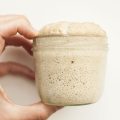We all know the precision required to create, feed and store a sourdough starter. Similarly, a sourdough discard requires some love and attention, in order to remain edible. While feeding isn’t a requirement, it is important to understand how to store sourdough discard properly. The best method is outlined in this article, so why not try it today?
![How To Store Sourdough Discard [Best Method] 1 How to store sourdough discard [best method]](https://www.mydailysourdoughbread.com/wp-content/uploads/2023/01/blog-images-50-720x405.jpg)
Table of Contents
- What Is Sourdough Discard?
- How To Store Sourdough Discard
- How Long Can I Keep Sourdough Discard In The Fridge?
- Can You Freeze Sourdough Discard?
- Does Sourdough Discard Spoil?
- Can Sourdough Discard Be Used To Make A New Starter?
- How to Use Sourdough Discard In Recipes
- Using Stored Sourdough Discard
- How to Store Sourdough Discard FAQs
What Is Sourdough Discard?
Sourdough discard is a portion of unfed starter that must be removed before every feed.
You should throw out the discard from your starter for the first 7 days. During this period the discard will contain bad bacteria, which is unsafe for consumption.
After 7 days, your starter should produce a nice rise and bubble, after which you can start to keep the discard in a separate jar for future bakes.
Much like your starter, the discard will only become better as it matures.
How To Store Sourdough Discard
The best way to store your unfed starter or sourdough discard is in the refrigerator. Place the discard into a labeled glass jar with the lid screwed on tight.
You can continue to top it up with fresh sourdough discard every day. Additionally, you could opt to freeze your sourdough discard if you don’t plan to use it right away.
When refrigerated the discard will be dormant, meaning that it will ferment at a very slow pace. Try not to keep your discard on the counter, unless you’re planning to bake some delicious sourdough discard treats on the same day.
How Long Can I Keep Sourdough Discard In The Fridge?
This will depend on the maturity of your sourdough starter. If your starter is mature, then it will certainly survive in the fridge for a long time. You could also treat it like an old starter, and revive it if you really wanted to.
However, if your starter is quite young i.e., less than 6 months old, then it won’t last very long in the fridge. The yeast and bacteria will not have been established just yet.
Despite the age of your starter, it’s better to store your discard in the fridge, instead of the counter where it will continue to ferment.
Sourdough discard left on the counter, unfed and unmaintained, will become very sour and acidic. Since it is quite literally a jar of unfed starter, it will eventually be taken over by bad bacteria and mold.
When stored in the refrigerator, your discard will go to sleep and last much longer.
![How To Store Sourdough Discard [Best Method] 2 How to store sourdough discard [best method]](https://www.mydailysourdoughbread.com/wp-content/uploads/2023/01/blog-images-51-720x405.jpg)
Can You Freeze Sourdough Discard?
Yes, you can certainly freeze your discard especially if you’re planning to use it in future bakes.
For best results, try freezing it one cup at a time. Though the perfect method of preservation is the freezer, sourdough discard is no stranger to freezer burn, which is why it’s best to freeze a little at a time.
Does Sourdough Discard Spoil?
As the discard ages, it will become sourer, and emit strong smells similar to nail polish remover. An active sourdough starter will often produce a pool of liquid on its surface called hooch, which is a clear sign that the starter is hungry. Your sourdough starter discard will behave in the same manner.
Simply stir the hooch back into the discard. The older the discard the stronger its flavor. Strong-flavored discard is best for sweet sourdough recipes like banana bread, or chocolate brownies.
Can Old Sourdough Starter Make You Sick?
Consuming old and bacteria-infested sourdough starters can cause a variety of illnesses. If you find that your discard sourdough starter has bits of mold in it, throw it away!
Can Sourdough Discard Be Used To Make A New Starter?
Yes, absolutely! Your fresh sourdough discard can be fed and gifted to a friend, who has just begun their sourdough bread journey.
Simply take a small portion of discarded starter, and plop it into a clean jar. Add equal parts of flour and water, and stir this together. For instance, 40 grams of discard plus 40 grams of fresh flour, and 40 grams of water equals a new starter!
How to Use Sourdough Discard In Recipes
Now that you know how to store your sourdough discard, it’s time to consider some delightful sourdough starter discard recipes. Using sourdough discard is a great way to eliminate waste, and familiarize yourself with a totally different flavor profile. Though sour, the discard usually harbors a hint of sweetness that is perfect for dessert recipes.
Here are some tips for you to try:
- Substitute discard into recipes like sweetbreads and muffins.
- Add them to recipes that don’t require much liquid, like sourdough chocolate chip cookies.
- Make sourdough bread recipes, but with a sweeter twist, like sourdough chocolate bread, or banana bread.
Using Stored Sourdough Discard
If you love sourdough as much as we do, then perhaps it’s time to sink your teeth into some of this delectable sourdough discard recipes.
How to Store Sourdough Discard FAQs
How Long Will Sourdough Discard Last?
Room-temperature sourdough discard should be refrigerated and can be used within 1-2 weeks.
Does Sourdough Discard Spoil?
Not necessarily. If sourdough discard is kept unrefrigerated it will become more acidic as time goes on.
Can You Use Day 1 Sourdough Discard?
No. It’s best you wait at least 7 days before you use any discarded portion of the starter.




![Bulk Fermentation Sourdough, Explained! [Your Easy Guide] 6 Bulk fermentation sourdough explained [easy guide]](https://www.mydailysourdoughbread.com/wp-content/uploads/2023/01/CD-blog-images-2023-01-05T180333.452-120x120.jpg)
![What You Need To Know About Coil Fold Sourdough [Doing It Right!] 7 What you need to know about coil fold sourdough [doing it right! ]](https://www.mydailysourdoughbread.com/wp-content/uploads/2023/01/blog-images-27-120x120.jpg)
